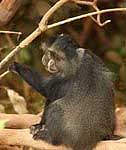Other Monkeys We Saw
Click here for the Black and White Colobus.
Click here for the Red-Tailed Monkey.
Click here for the Vervet Monkey.
BLUE MONKEY

How to Recognize
Blue monkeys are very similar to the vervet monkey but they are slightly larger and much darker.
They have grey-black faces and black shoulders, limbs, and tails. Their backs are reddish-brown or
olive-brown black. They are common to find, but difficult to actually see among the foliage as they are shy.
Habitat
Blue monkeys are mostly seen in trees, and they prefer dense forests and woodlands rather than the
savannah. They are widely distributed in most evergreen forests and forest patches.
Behavior
Blue monkeys live in social groups as large as thirty, but they generally prefer troops between four and
twelve. Blue monkeys are active during the day, and they are occasionally terrestrial.
The male of the troop guards the group against other troops and males, and the females tend to join in
these confrontations. When a take over occurs, the male is often ousted from the group. Additionally,
blue monkeys form alliances with other monkeys such as red-tailed monkeys or the red colobus for
added protection against predators.
Breeding
Breeding occurs throughout the year after a gestation period of five months. The female gives birth
to a single offspring.
The young are relatively well developed at birth, with open eyes and the capability to grasp their
mother and support their own weight. The young are weaned at about six months, and they
reach sexual maturity at about three years.
Feeding
Blue monkeys are vegetarians, feeding largely on foliage, fruits, bark, gum, and leaves.
Enemies
Their enemies include leopards and eagles. In Uganda, blue monkeys are hunted for their meat.
TOP OF PAGE
Copyright © 2002, Dawn M. Dalton.
All rights reserved.
**LINKS**
WHERE?
WHY?
ITINERARY
PLAN YOUR TRIP
GETTING THERE
LONDON
KENYA
UGANDA
SAFETY
ITEMS BOUGHT
STAYING HEALTHY
COMMENTS
HOME
BHS HOME
---Animal Facts--
Baboon
Buffalo
Cheetah
Chimpanzee
Crocodile
Eland
Elephant
Gazelle
Giant Forest Hog
Giraffe
Gorilla
Hippopotamus
Hyena
Hyrax
Impala
Jackal
Lion
Mongoose
Monkey
Ostrich
Rhinoceros
Topi
Uganda Kob
Warthog
Waterbuck
Wildebeest
Zebra